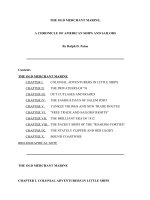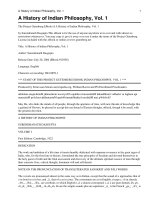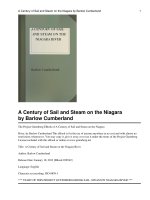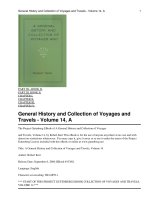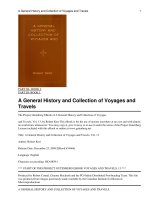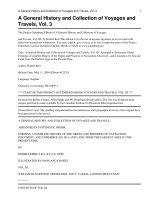The Beaver Hills Country - A History of Land and Life (Au Press) ppt
Bạn đang xem bản rút gọn của tài liệu. Xem và tải ngay bản đầy đủ của tài liệu tại đây (6.03 MB, 264 trang )
The Beaver hills CounTry
73851 lim1-10_cb 7/30/09 10:47 AM K 1
73851 lim1-10_cb 7/30/09 10:47 AM K 2
The Beaver hills CounTry
A History of Land and Life
Graham A. MacDonald
73851 lim1-10_cb 7/30/09 10:47 AM K 3
© 2009 Graham A. MacDonald
Published by AU Press, Athabasca University
1200, 10011 – 109 Street
Edmonton, AB T5J 3S8
Library and Archives Canada Cataloguing in Publication
MacDonald, Graham A. (Graham Alexander), 1944–
The Beaver Hills country: a history of land and life/Graham A. MacDonald.
Includes index.
Also available in electronic format (978-1-897425-38-1)
ISBN 978-1-897425-37-4
1. Strathcona (Alta.: County) – History. 2. Strathcona (Alta.: County) –
Biography. I. Title.
FC3695.B43M33 2009 971.23'3 C2009-901824-1
Cover design by Valentino Gerard
Book design by Infoscan Collette, Québec
Back cover photo: LAC. C-030279
Front and back cover skies: Photos.com
Printed and bound in Canada by Marquis Book Printing
This publication is licensed under a Creative Commons License, see
www.creativecommons.org. The text may be reproduced for non-commercial
purposes, provided that credit is given to the original author.
Please contact AU Press, Athabasca University at
for permission beyond the usage outlined in the Creative Commons license.
This book was funded in part by the Alberta Historical
Resources Foundation.
73851 lim1-10_cb 7/30/09 10:47 AM KCMY 4
ConTenTs
Acknowledgments. . . . . . . . . . . . . . . . . . . . . . . . . . . . . . . . . . . vii
Introduction On the Name “Beaver Hills”. . . . . . . . . . . . . 1
Chapter One The Character of the Beaver Hills . . . . . . . . 9
Chapter Two Ancient Ways Between Two Rivers . . . . . . . 23
Chapter Three Traders, Horses, and Bison, 1730–1870 . . . . 33
Chapter Four Visions of the Promised Land, 1870–1905. . . 59
Chapter Five Conservation, Communities and
Egalitarianism, 1905–1930. . . . . . . . . . . . . . . 97
Chapter Six Hard Times and Good Times, 1930–1950. . . 137
Chapter Seven Postwar Urbanism . . . . . . . . . . . . . . . . . . . . . 155
Notes . . . . . . . . . . . . . . . . . . . . . . . . . . . . . . . . . . . . . . . . . . . . . 179
Bibliography . . . . . . . . . . . . . . . . . . . . . . . . . . . . . . . . . . . . . . . 221
Image Sources. . . . . . . . . . . . . . . . . . . . . . . . . . . . . . . . . . . . . . 243
Index . . . . . . . . . . . . . . . . . . . . . . . . . . . . . . . . . . . . . . . . . . . . . 247
73851 lim1-10_cb 7/30/09 10:47 AM K 5
73851 lim1-10_cb 7/30/09 10:47 AM K 6
aCknowledgmenTs
T
his book developed out of an earlier enquiry into the history
of the bison conservation story at Elk Island National Park
undertaken for Parks Canada. The broader natural, social and
economic history of the Beaver Hills seemed to invite scrutiny. The
post-1880 years are the richest in a documentary sense, but there
is great time depth to the hills and an effort has been made to
outline the shifting character of the hills since glacial times. I must
first thank for unrecorded discussions and assistance the many
colleagues who encouraged this line of enquiry. Thanks are also
owing to many individuals who shared stories and to organizations
which shared information and photography. To all those known
and anonymous editors and contributors who laboured to produce
the many large and profusely illustrated local histories pertaining
to central Alberta, I owe a great debt. Special thanks to Don
Wetherell and Don Purich for their reading of earlier versions of
the manuscript. At AU Press, I am grateful to Walter Hildebrandt,
Erna Dominey and Carol Woo for their encouragement and dis-
ciplined interest in seeing the manuscript through to publication.
73851 lim1-10_cb 7/30/09 10:47 AM K 7
viii
Beaver Hills Country: A History of Land and Life
73851 lim1-10_cb 7/30/09 10:47 AM KCYM 8
Introduction ix
73851 lim1-10_cb 7/30/09 10:47 AM KCYM 9
x
Beaver Hills Country: A History of Land and Life
73851 lim1-10_cb 7/30/09 10:47 AM KCMY 10
inTroduCTion
On the Name “Beaver Hills”
T
he Beaver Hills rise subtly out of a hospitable and moist mixed-
farming region identified with the Aspen Parkland, a web of
grasslands and trees running in a broad swath from south-central
Manitoba towards Edmonton. Trees characteristic of this region
include the Trembling Aspen and the Balsam Poplar, along with
willows. Manitoba Maple and Burr Oak appear in the eastern
portions of the range south of the Qu’Appelle River. A variety of
other species are found, some associated with the Boreal Forest to
the north and others with more southerly climes that favour deciduous
growth. Thus, in the Beaver Hills one can find the Paper Birch, White
and Black Spruce and Tamarack.
This Aspen Parkland belt is one of the distinctive Canadian
landscapes, for many centuries providing favoured wintering areas
for the great herds of bison. The groves of trees were a source of
shelter from the bitter prairie winds while much-needed grass could
also be found for winter forage. It is a genuinely transitional type
of landscape, embodying elements of the somewhat more uniform
features which lie to the north and south of the belt.
1
These diverse
qualities have made the uplands an important place of resort for
many generations of Native peoples.
73851 001-254_cb 7/30/09 10:48 AM K 1
2
Beaver Hills Country: A History of Land and Life
Representations of these gentle hills have appeared in European
cartography since the mid-eighteenth century. On a map prepared
in 1760 under the sponsorship of Moses Norton, Chief Factor
for the Hudson’s Bay Company at Churchill Fort, what is clearly
the North Saskatchewan River is identified as the Beaver River.
The map shows “Beaver Mount” from which there is a trail route
described as “Ye track to Henday’s tent.” The chart was, Norton
claimed, “Laid Down on Ind’n Inform’n” gathered no doubt with
the assistance of Attickasish, “that trusty leader” who had con-
ducted Anthony Henday in his Journey inland to the Earchithinues
country in 1754–55.
2
The identification of “Beaver Mount” is prob-
ably an early intimation of the Rocky Mountains, the presumed
source of the Saskatchewan River. On Norton’s map, however,
only the presence of a river flowing from this western quarter was
known, for “ye river Kish-stock-ewen” is misconceived and appears
on his chart as the river flowing east in to Baker Lake, far to the
Aspen Parkland Belt, 1915 The Aspen Parkland in Western Canada, shown in
mottled pattern, runs in a northwest direction from the Red River Valley of Manitoba,
across Saskatchewan and into central Alberta where it then follows a line south along the
edge of the foothills.
73851 001-254_cb 7/30/09 10:48 AM KCMY 2
Introduction 3
north. By 1774, however, a map produced by Andrew Graham
demonstrated a fairly modern understanding of the course of the
Saskatchewan River.
3
In 1793, Hudson’s Bay Company cartographer and explorer
Peter Fidler made rough reference sketches of the Beaver Hills
on a number of occasions. Beaver Hills Lake appears prominently on
David Thompson’s great final map of western North America of
1814. Thompson remarked upon the hills, along with their currency
in Native parlance, indicating that they were an area of resort
amongst several of the major tribes, especially the Cree and Sarcee.
4
For the Cree the hills were known as the a-misk-wa-chi, which
captures the notion of a place rich in beaver. Among the Stoney
they were called the chaba hei. To the Blackfoot they were the
kaghghik-stak-etomo. Beaver Hills Lake was called by the Blackfoot
the “Kakghikstakiskway – the place where the beaver cut the wood.”
5
John Palliser’s British-sponsored scientific expedition of the
late 1850s entered the hills from the eastern side. On the published
maps accompanying Palliser’s Report, the hills appear a little more
boldly than today’s atlas makers would probably render them. The
hills had registered on Palliser’s men with some force. In late 1857,
James Hector’s segment of the party, moving westerly and south
of the North Saskatchewan River, “soon came in sight of the Beaver
Hills, a low blue line to the S.W. of us, evidently thickly wooded.”
About a year later Hector gave a more detailed account of his
impression of the land on the eastern edge of the hills through to
the western side:
I crossed the Egg Hills which are 300 feet above the plain and
to the south-west of which lies a large lake of the same name.
Its margins are very swampy, and it was swarming with ducks,
geese, swans, and other wild fowl at this season. From the north
end of the lake we struck through dense poplar thickets, which
continue all the way to the northwest angle of the Beaver Hills,
where we again fell on the Edmonton Track.
About the possibilities inherent in this area, Hector stated: “I
was much struck with the admirable pasture which is to be found
73851 001-254_cb 7/30/09 10:48 AM K 3
4
Beaver Hills Country: A History of Land and Life
even at this season all over this extensive tract of country, and of
that kind which is most valuable for the support of animals during the
winter.” The poplar thickets “affording shelter surround and enclose
Moses Norton’s Draught of the Northern Parts of Hudson’s Bay (1760)
This Hudson’s Bay Company map was compiled on the basis of reports from other
traders and guides. Redrawn in this version by Richard Ruggles, it identifies, very
imperfectly, some of the main features of Western Canada and the Rocky Mountain
barrier in the vicinity of the source of the Saskatchewan River.
73851 001-254_cb 7/30/09 10:48 AM K 4
Introduction 5
limited prairies that yield a rich growth of vetches and nutritious
grass of sufficient growth to bear up the snow and keep it loose,
so that horses and cattle can scrape their food from under it at
least until the later spring months, when in some winters, the
crust might be a serious obstacle.” Hector noted spots “where
there is a deep rich soil admirably adapted to agriculture” and
which are “to be found in every direction.”
6
In the mid-1880s, the ubiquitous Joseph B. Tyrrell of the
Geological Survey of Canada remarked upon the hills which he
found lying east of the Calgary-Edmonton Trail: “there is appar-
ently high and thickly wooded country which goes by the name of
Amisk-wachi or Beaver Hills.” Of this country “little could be
learned even among those who were living in the immediate vicin-
ity, and it has been left as a hunting ground for the Indians who
yearly kill a large number of moose in the deep recesses of its
forests.” Having gained some firsthand acquaintance of the terrain,
he remarked upon their “most striking feature” which was “the
absence of the rough hill character which this name would lead
one to expect.” In fact, the “country is found to be simply low
ridges or sandy knobs, often thickly covered with large balsam,
poplar and spruce separated by valleys drained by numbrous small
streams.” The hills were apparently well named, for “these streams
have everywhere been dammed back by beaver giving rise to exten-
sive meadows.” Some of these were “impassable marshes” but others
where beaver dams had been broken down “are again drained by
the creeks and form beautiful and wide alluvial tracts covered in
long grass” sufficient to provide hay for “large herds of cattle
and horses.”
7
A few years later, some of the first Irish settlers at Deville, near
Hastings Lake, confirmed the presence of Native hunting grounds
of both ancient and recent vintage. Stone tools, arrowheads and other
projectile points, as well as “pemmican balls” were regularly turned
up in the new fields.
8
A formal beginning on the ethnology of the area
was commenced in 1892 by that rambling and literate veteran of the
Hudson’s Bay Company, Isaac Cowie. At the request of the eminent
73851 001-254_cb 7/30/09 10:48 AM K 5
6
Beaver Hills Country: A History of Land and Life
scholar, Franz Boas, he saw to the collecting and safekeeping of a
substantial amount of Cree artifacts drawn mainly from the Bear
Hills area of the Battle River Valley, near Wetaskiwin.
9
Some 35 years after Tyrrell’s observations, Alex McCauley,
the Mayor of Tofield, gave an address in which he recalled the hills
in earlier times:
The large lake at our door was called Beaverhills Lake and the
country for over twenty miles west of this lake was called
the Beaver Hills, owing to the large number of beaver being
found here. Amisk Creek, a few miles east of Town was given
its name for the same reason, “Amisk” being the Cree word for
Isaac Cowie (1848-1917) This veteran Hudson’s Bay Company trader had a literary
bent and an interest in Native cultures. He made a collection of Cree artifacts and
material culture items from central Alberta for the American anthropologist, Franz
Boas. The materials are now in the Field Museum of Natural History in Chicago.
73851 001-254_cb 7/30/09 10:48 AM K 6
Introduction 7
beaver. Like the evergreen island you can see from Cooking
Lake Station, these hills were covered with jackpine, spruce
and tamerac, and the depressions between the hills with water.
In this forest were to be found buffalo, bear, moose, deer, as
well as beaver and on the lake swam geese, ducks, pelicans and
all kinds of waterfowl by the thousands. During the first part
of the nineties fire destroyed this great forest.
10
Over the years there have been many references to the hills, to
their reputation as a traditional hunting ground for beaver, and as a
well-watered haven for birds and wildlife. While the place name has
persisted, Mayor McCauley’s testimony reinforced a tradition of
commentary which began around the turn of the century. This body
of opinion suggested that the hills had undergone radical changes in
the early settlement period, particularly through the agency of fire.
This tradition was still alive in the 1960s when questions concerning
the ideal character of the hills became points of departure for natu-
ralists and parks and lands administrators then seeking to develop a
more coherent and reasonable policy for human use of the hills. “If
it could only talk, what stories Beaverhills Lake could tell!” exclaimed
a local historian at Tofield.
11
The following chapters will attempt to
relate some of those stories and to see the hills when they were part
of more distant theatres of human action.
73851 001-254_cb 7/30/09 10:48 AM K 7
73851 001-254_cb 7/30/09 10:48 AM K 8
ChapTer one
The Character of the Beaver Hills
A
s a place name, the Beaver Hills has a long history both in
common parlance and through the mapmaker’s art. Despite
long standing popular use of the name Beaver Hills, a cooler and
more scientific designation for them also exists: the Cooking Lake
Moraine. In this designation the inherent glacial origin of the hills
is acknowledged. The key to their present surface forms may be
found in local glacial history. While many of the landforms around
Edmonton were created through the draining actions of the great
Glacial Lake Edmonton and its associated spillway channels, the
Cooking Lake Moraine has been described as a “spectacular excep-
tion” to this process. The moraine was formed on high ground
along a broad front “where the ice sheet stagnated and melted
away.”
1
The absolute position of the hills, before they were hills,
was along the main edge and contact zone between two great clashing
systems of ice: the mountain glaciers which flowed out of the
Rockies and the great ice sheet which covered the plains and
Canadian Shield, having advanced from the northeast. At the
glacial maximum, some 21,000 years ago, only the odd elevation on
the prairies, such as the Cypress Hills, poked heads above the great
73851 001-254_cb 7/30/09 10:48 AM K 9
10
Beaver Hills Country: A History of Land and Life
ice sheet. Such unglaciated aspects, or “nunataks,” were not present
in the Beaver Hills, for these uplands were themselves formed only
as the outcome of late glacial erosion and melting. As the ice
receded, what was left, in Roger Morton’s words, was “a drastically
modified landscape, bearing the erosive scars of glaciation and
littered with the debris of destruction.” Around Cooking Lake, for
example, great “slices of bedrock were bulldozed out and dumped
by the ice.” Where no hills had been before, there was now deposited
a confused and jumbled base.
2
Glacial Lake Edmonton As the ice of the last glaciation receded, large temporary lakes
were formed at the edge, such as Glacial Lakes Peace and Edmonton. The latter had an
important influence on the final arrangement of soils and lakes in the Beaver Hills.
73851 001-254_cb 7/30/09 10:48 AM KYC 10
The Character of the Beaver Hills 11
When the glaciers started to lose their punch about 12,000 years
ago, melting actions left behind some large archaic lakes, such as
Glacial Lake Edmonton, a lake that was quite short lived.Its gradual
drainage left extensive secondary deposits composed of finer mate-
rial atop some of the uprooted and tumbled layers of bedrock,
producing distinctive landscapes such as the Cooking Lake Moraine.
The “hummocky” nature of the hills was described by local natu-
ralist Deirdre Griffiths as a classic example of what geographers
call “knob and kettle topography” terrain. Such landforms indicate
that there had been large, slow-melting chunks of glacial ice embed-
ded in the moraines during the early phases of glacial recession.
3
In the Beaver Hills many small, sometimes land-locked ponds
gradually developed in the depressions, the product of the subsur-
face melting of these large chunks of buried glacier ice. The pattern
of these wetlands is still visible today.
Decline of Ice in the Edmonton Area This block diagram by J.D. Godfrey,
superimposes the future locations of Fort Saskatchewan and Edmonton on the chaos
of the melting glacier. Ice is still shown over the Beaver Hills area.
73851 001-254_cb 7/30/09 10:48 AM KCMY 11
12
Beaver Hills Country: A History of Land and Life
In the nine millennia since, belts of primary vegetation slowly
developed across western North America. On a grand scale this
involved the gradual configuration of boreal forest to the north
and grasslands to the south. These two large classes were divided
only by the broad area of ecological compromise called the Aspen
Parkland belt. This great arc of trees intermixed with grass defines
a transition vegetation zone between the true prairie to the south
and the boreal zones to the north. The unique dynamics of the
Aspen Parkland are driven by a combination of fire and moisture
availability, and together these produce substantial tree growth with
a successional cycle ideally terminating in spruce growth. Since
the fifteenth century, climatic conditions on the prairies have been
relatively unchanged, with the pattern of short-and tall-grass
prairies and the Aspen Parkland stabilized in a pattern generally
similar to the one we see today.
4
The boundaries of these belts have never been absolute and
instead have been subject to movements north or south in keeping
with long-term shifts in climate. At times, as in the 1930s, periods
Elk Island Golf Course At the golf course near Lake Astotin, players get a view
of the nature of moraine topography.
73851 001-254_cb 7/30/09 10:48 AM K 12
The Character of the Beaver Hills 13
of drought set in. If such drought conditions persisted the vegeta-
tion patterns adjusted accordingly, producing this boundary-shift
phenomenon. So severe was the prairie drought in the period from
1200 to 1400 A.D. that some have argued for a general abandonment
by both human and animal in much of the lands to the east of the
central and southern Rocky Mountains. This particular drought was
no ordinary one, but was brought on by the movement of the winds
somewhat to the north of their normal latitude of operation. In the
resulting rain shadow that developed east of the mountains, little
lived, or so it would seem.
5
Conclusions such as these are more by way of impressions
gained by modern environmental scientists; but archaeologists can
sometimes confirm these suspicions at selected sites, if only imperfectly.
Addressing the questions arising out of a knowledge of such broad
shifts in climatic and vegetation conditions has become an important
driver of post-war archaeological enquiry. The archaeologist seeks
an understanding of the ways in which people adapted to such
fundamental changes. While many tools of ancient Albertans have
been found and examined since the 1960s, the reconstruction of
the environmental contexts of such finds is the other task of the
modern archaeologist.
6
With the assistance of that profession, it is
here and there possible to follow in the footprints of a succession
of different peoples, all of whom undertook activities shaped by
their own contemporary relationships with land and life.
7
The Aspen Parkland belt was of great significance to those
who frequented the high plains in earlier periods. The open prairie
in pre-horse times was a hostile environment. Use of tree-lined
water courses, the uplands, or the relative shelter of the Aspen
Parkland were central requirements in the relatively sedentary life
of pre-eighteenth century times. Nomadism was certainly a reality,
but communities were also rooted in localities; people only picked
up and moved when necessary. The home base was significant for
the opportunities it afforded for collecting plants, herbs, and berries.
Hunting forays could depart from such a base camp in a familiar
territory. In the treed portions of the Parkland, groups of hunters
73851 001-254_cb 7/30/09 10:48 AM K 13
14
Beaver Hills Country: A History of Land and Life
drove the bison into a pound, which operated rather like both a
trap and a corral.
8
At its far western limit the parkland belt curves through
Edmonton and Wetaskiwin, then moves south along the foothills
towards Calgary and on to the American border, the tree roots
benefiting from the river systems and sufficient localized rainfall.
Nestled in the inner edge of the arc where the parkland turns south,
lying between the North Saskatchewan and the Battle River, are
the Beaver Hills.
During fur trade times, the hills became identified with the
early fur posts of the Edmonton area. Later, along with the adjacent
plains, they provided the initial settlement frontier for a large
numbers of pioneers, including many of Ukrainian origin. These
pioneers started to arrive in the early 1890s and many found that
wresting a living from this topsy-turvy landscape was not always
Aerial view of the Beaver Hills, Elk Island National Park vicinity
73851 001-254_cb 7/30/09 10:48 AM KCMY 14
The Character of the Beaver Hills 15
easy or rewarding. It is appropriate that one of the closest students
of this post-glacial landscape was the geologist Luboslaw Bayrock
(1930–1989), a post-war immigrant to Alberta from Ukraine. His
surveys and map work did much to fathom the character of the
geological forces which had shaped the river valleys, rolling hills
and prairies of central Alberta, the same lands which many of his
compatriots had worked so hard to tame in the years after 1897.
9
It will be helpful to keep in mind the rather unusual circum-
stances of vegetation history in the hills as we make the journey
from past to present. The vegetation cover indicates that while the
Beaver Hills are in the parkland belt they are not quite of it. This
was the conclusion of S.C. Zoltai, an authority on forest history,
who closely studied the internal composition of the Aspen Parkland
and its regional variants. He found a strong aspect of the Boreal
Forest in the northern fringes of the belt, particularly in the Beaver
Hills.
10
For this reason, the unique qualities of the hills have been
described as follows: “Elk Island and the Beaver Hills are elevated
above the Aspen Parkland that surrounds the hills” and are con-
sidered to be “part of the Boreal Mixedwood Forest.”
11
That is, the
hills seem to partake somewhat more of the northern forest than
southern plains. The significance of this particular suggestion, we
will see later, came to be debated at some length by park adminis-
trators and research scientists at Elk Island National Park in the
1960s. The supposed transitional features of the landscape have
become somewhat blurred by historic land use practices and fire
suppression, but they may still be noticed during a north to south
tour of the hills. The northern aspect reveals a thicker forest tending
towards spruce, while in the south the character is more towards
open Aspen stands punctuated by extensive grasslands.
12
Such rolling country, along with the well-wooded river valleys
which coursed through it, was naturally recognized and used by
generations of ancient Aboriginal folk. The ultimate identities of
the most distant inhabitants remain obscure; but it is certain that
various peoples came and went during the many centuries prior
73851 001-254_cb 7/30/09 10:48 AM K 15
